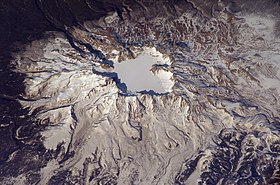Changbai Mountain
| Mount Paektu | |
|---|---|

Mount Baekdu, April 2003
|
|
| Highest point | |
| Elevation | 2,744 m (9,003 ft) |
| Prominence | 2,593 m (8,507 ft) |
| Listing |
Country high point Ultra |
| Coordinates | 42°00′20″N 128°03′19″E / 42.00556°N 128.05528°ECoordinates: 42°00′20″N 128°03′19″E / 42.00556°N 128.05528°E |
| Geography | |
| Location |
Ryanggang, North Korea Jilin, China |
| Geology | |
| Mountain type | Stratovolcano |
| Last eruption | 1903 |
| Paektu Mountain | |||||||||
| Chinese name | |||||||||
|---|---|---|---|---|---|---|---|---|---|
| Simplified Chinese | |||||||||
| Traditional Chinese | |||||||||
| Literal meaning | "Ever-white Mountain" | ||||||||
|
|||||||||
| Baekdu Mountain | |||||||||
| Simplified Chinese | |||||||||
| Traditional Chinese | |||||||||
| Literal meaning | "Whitehead Mountain" | ||||||||
|
|||||||||
| Korean name | |||||||||
| Hangul | |||||||||
| Hanja | |||||||||
|
|||||||||
| Manchu name | |||||||||
| Manchu script |  |
||||||||
| Romanization | Golmin Šanggiyan Alin | ||||||||
| Transcriptions | |
|---|---|
| Standard Mandarin | |
| Hanyu Pinyin | Chángbáishān |
| Wade–Giles | Ch'ang-pai Shan |
| Transcriptions | |
|---|---|
| Standard Mandarin | |
| Hanyu Pinyin | Báitóushān |
| Wade–Giles | Pai-t'ou Shan"Pai-t'ou Shan: China". |
| Transcriptions | |
|---|---|
| Revised Romanization | Baekdusan |
| McCune–Reischauer | Paektusan |
Mount Paektu or Mount Baekdu is an active volcano on the border between North Korea and China. At 2,744 m (9,003 ft), it is the highest mountain of the Changbai and Baekdudaegan ranges. North and South Koreans consider the volcano and its caldera lake to be their countries' spiritual home.
It is also the highest mountain on the Korean Peninsula and in Northeast China. A large crater lake, called Heaven Lake, is in the caldera atop the mountain. The caldera was formed by the VEI 7 "Millennium" or "Tianchi" eruption of 946, which erupted about 100–120 km3 of tephra. This was one of the largest and most violent eruptions in the last 5000 years (alongside the Hatepe eruption of Lake Taupo at around 180 AD and the 1815 eruption of Tambora).
The modern names of the mountain in Chinese and Korean come from the Sushen or Proto-Jurchen language of the Manchu peoples. Its modern Manchu name is Golmin Šanggiyan Alin or Long/Ever White Mountain. Similarly, its Mongolian name is Ondor Tsagaan Aula, the Lofty White Mountain.
In Chinese, the mountain itself is known as Chángbáishān ("Ever White Mountain") but the mountain and Heaven Lake taken together are known as Báitóushān ("Whitehead Mountain"). This later name, read in Korean and variously romanized, is the source of the North Korean name Paektu-san and South Korean Baekdu-san. In English, various authors have used non-standard transliterations.
...
Wikipedia

